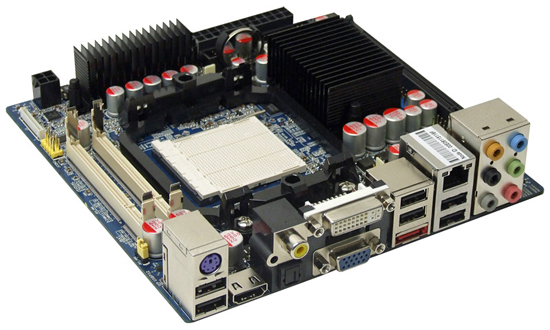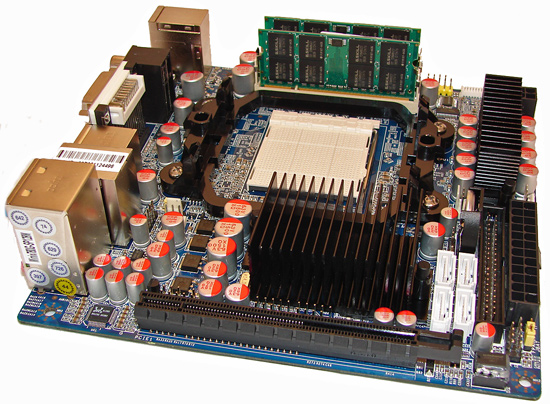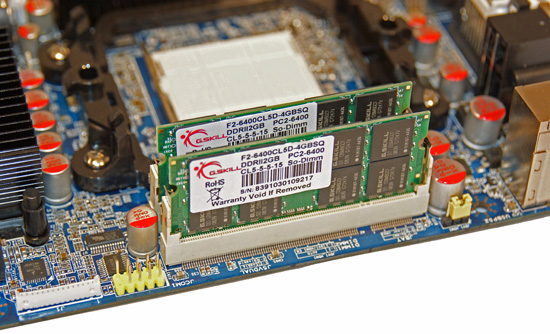Lab Notes - J&W MINIX 780G-SP128MB
by Gary Key on November 13, 2008 3:00 AM EST- Posted in
- Gary's First Looks
We recently received several mini-ITX form factor boards for an upcoming HTPC guide. These boards represent a wide variety of chipsets ranging from the Intel G45 to the NVIDIA GF8200. However, none of them prepared us for the motherboard that we received from J&W Technology.
Based on the AMD 780G chipset, the MINIX 780G-SP128MB is one of the most impressive motherboard designs we have seen in the labs recently. Impressive not only from an aesthetic and layout viewpoint, but the quality of components and available ports put this board ahead of our other candidates. However, since it is based on the 780G chipset, the board carries a penalty for HTPC users as multi-channel LPCM via HDMI output is not available. If you can live without that feature then we highly recommend this board.

J&W managed to shoehorn four SATA 3Gbps ports, IDE connectivity, a physical x16 PCIe 2.0 slot, two SO-DIMM slots, a USB 2.0 header providing four additional ports, COM header, IR connector, and an iPartner Control Center header. The PCIe x16 slot actually operates at x4 electronically due to the limitation of available trace counts on the mini-ITX board design. This could be seen as a limitation, but the primary purpose of the board was never to be a high-end gaming system.
That said, we have not noticed any real performance differences when utilizing our HD 4350, HD 4550, or HD 4670 video cards on this board compared to a uATX 780G board from Gigabyte. In fact, an HD 4350 card on this board will offer improved casual gaming performance while also providing multi-channel LPCM audio for another $30 if a user wanted to go that direction. The board supports Hybrid graphics although your money is better spent on a HD 4550 card instead of the previous generation HD 3450. J&W also included 128MB of 800MHz DDR2 memory for side-port functionality.
This board supports current 45W/65W/95W TDP AM2/AM2+ processors including the Phenom 8750 and 9350e series. J&W explicitly states that 125W or higher processors are not supported due to the three phase power delivery design. An additional warning is also provided that 95W TDP processors should only be utilized if proper heat dissipation is available for both the CPU and motherboard.
A single heatsink covers the 780G Northbridge and SB700 Southbridge. Unless your case is well ventilated, the chipset heatsink will require additional airflow to keep thermals under control. Fortunately, J&W is shipping a fairly quiet AVC Digital Home Series 4010 DC fan with the kit. Three fan connectors are included along with decent BIOS support for monitoring and control.
The board features a loaded I/O panel that consists of a PS2 keyboard port, six USB 2.0 ports, Optical and RCA S/PDIF ports, VGA/HDMI/DVI output, an eSATA port run off the SB700, an RJ45 Gigabit Ethernet port, and a audio panel featuring six 3.5mm jacks for the Realtek ALC 885 7.1 channel HD codec.

Installing SATA cables requires some forethought as the area between the heatsink, SATA/IDE ports, and the 24-pin ATX power connector is cramped. We installed the SATA cables on the board before case installation to alleviate any potential problems.

The MINIX 780G-SP128MB features 4GB memory support that is provided by two DDR2 200-pin SO-DIMM slots. This board supports DDR2-533, DDR2-667, DDR2-800, and DDR2-1066 memory speeds. DDR2-1066 support requires a Phenom based processor but without . We purchased 4GB of GSkill DDR2-800 with timings of 5-5-5-15 at 1.8V for $49, so there is not a significant cost penalty for using SO-DIMMs unless you are trying to locate the DDR2-1066 variety.
In the end, J&W has designed and produced a well engineered motherboard that has us excited about the mini-ITX market again.
















20 Comments
View All Comments
JonnyDough - Friday, November 14, 2008 - link
I would have to agree. Also, what is the point of legacy PS/2 ports? Get RID of them! If you're building an HTPC what are the odds you'll use one anyway? Hello, wireless keyboard and mouse via USB?JoeWPgh - Friday, November 14, 2008 - link
You need the PS/2 keyboard to get into the BIOS. I don't know if that's a limitation of the chipset or the BIOS itself. Besides, if your keyboard batteries go dead in the middle of the night, you can drag the old PS/2 KB out of the closet til the stores open in the morning.strikeback03 - Friday, November 14, 2008 - link
To get into the BIOS on this board? Because that is certainly not a limitation on all boards. I run a couple of systems (1 P965, 1 nForce4) where Bluetooth keyboards with USB dongles work fine for everything, including BIOS.JoeWPgh - Saturday, November 15, 2008 - link
It's the only real annoyance I've come aross with board. It's not that big of a deal, because I don't go into the BIOS very often after a machine is set up. I also don't mind that there's a PS/2 port on the back, as I don't see what it's presense disallows. Now, the VGA port? You really gotta wonder why that's still there.GaryJohnson - Saturday, November 15, 2008 - link
agreed. haven't seen a system with the usb keyboard/bios limitation since socket7.JonnyDough - Friday, November 14, 2008 - link
I also want to add that the VGA port is just stupid. There are simple DVI to Analog adapters for that. I mean really, if they got rid of the legacy stuff (there are also basic USB to PS/2 adapters), they could have included HD audio and so on. Why would anyone build something that revels in the past, when the future tech is so much better?Calin - Monday, November 17, 2008 - link
The 690G (and probably the 780G) can't send analog signal over the second, DVI link - only analog signal on the VGA link and digital signal over the DVI link.This goes one more step: you can use the HDMI output (if available) only with the VGA, and the TV-out (analog) only with the DVI
3DoubleD - Friday, November 14, 2008 - link
I think the problem is that this motherboard wasn't designed exclusively for an HTPC. In fact, I don't think there are many (or any) boards exclusively built for HTPCs. It is likely this board includes the VGA and DVI for dual monitor support. The HDMI is a nod to the HTPC crowd. As for the PS/2 port, I hope they never get rid of these. Nothing is worse than not being able to get into the BIOS if you need to because you have a USB keyboard that won't initialize until after the POST screen has past. I'm very glad they removed the PS/2 mouse support though. In regards to HD audio, I think that the only modern high quality alternative is the LPCM over HDMI pass through. Analog integrated audio will never cut it, even if they call it "HD" audio. If you can't use LPCM, get a discrete sound card as the analog audio quality is drastically better due to the use of better opamps and better isolation from the motherboard EMI. If you don't have that choice, I'd go with optical S/PDIF, but then you are down sampling to DD5.1.It really depends on your priorities, but with the availability of Nvidia's 9300 chipset and cheap ATI 4350s along with inexpensive HDMI A/V recievers, I think the LPCM over HDMI is the only option for a real home theater PC. On the other hand, if you are just building a box that will connect straight to a TV (both audio and video), then who cares.
jarthel - Friday, November 14, 2008 - link
[quote]There are plenty of M-ITX board out there that have full-on PCIe x16 slots. Of course, these boards are two or three times J&W's price. [/quote]and there in lies the answer to the PCIe 4x slot.
Mr Perfect - Friday, November 14, 2008 - link
Agreed. That's what I was getting at. They should just come out and say that it was a cost cutting measure to deliver a reasonably priced board.It is not "due to the limitation of available trace counts on the mini-ITX board design" in general, but is due to the available trace counts on THEIR mini-ITX board design.